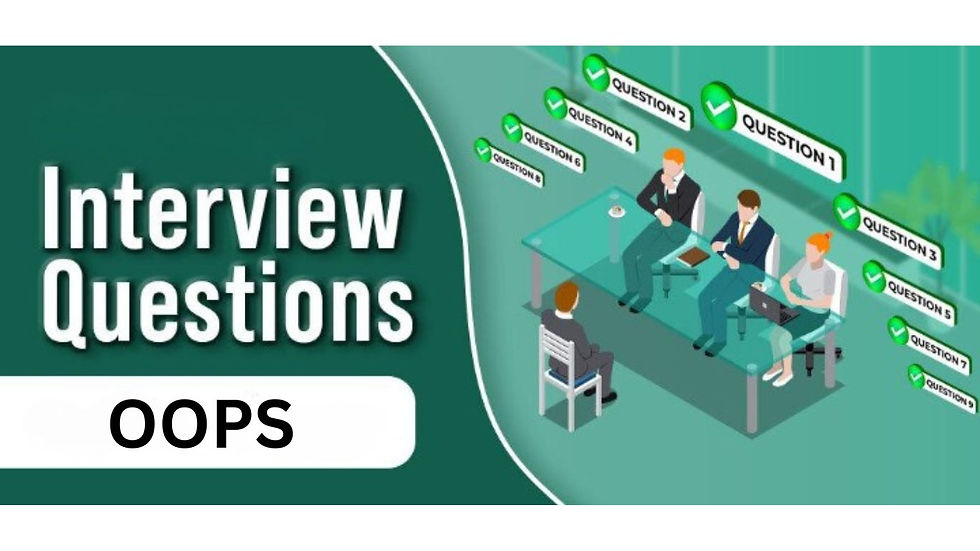What are some interesting questions asked in an flutter interview?
- Divyansh WsCube
- Oct 20, 2023
- 3 min read

Introduction
Flutter has transformed the mobile app development landscape with its powerful cross-platform capabilities and delightful user interfaces. As the demand for Flutter developers continues to rise, job interviews are becoming more intriguing and challenging. In this blog, we'll delve into some of the interesting and thought-provoking questions that you might encounter in a Flutter interview, designed to test your in-depth knowledge of this innovative framework.
1. How does Flutter achieve its goal of delivering a consistent user experience across platforms?
Answer: Flutter provides a comprehensive set of widgets that adapt to the platform's design guidelines, ensuring a consistent user experience. It achieves this through the use of its own rendering engine and widget library.
Insight: This question assesses your understanding of Flutter's unique approach to cross-platform development.
2. Can you explain the concept of "widget tree" in Flutter?
Answer: The widget tree is a hierarchical structure of widgets that represents the user interface of a Flutter app. It includes both built-in and custom widgets, organized in a tree-like structure.
Insight: A grasp of the widget tree is fundamental to Flutter development, as it's how the user interface is built.
3. What are "keys" in Flutter, and when should they be used?
Answer: Keys are used to uniquely identify widgets in the widget tree. They're particularly important when working with dynamic widget lists or when you need to preserve state during widget updates.
Insight: Knowing when to apply keys showcases your understanding of efficient widget management.
4. How does Flutter handle layout and positioning of widgets?
Answer: Flutter employs a flexible layout system that includes rows, columns, and the Flex widget. Widgets like Expanded help control how widgets are sized and positioned within the layout.
Insight: Layout and positioning are essential aspects of UI design in Flutter, and you should be well-versed in these concepts.
Also Read: What are the html interview questions that are tricky and require presence of mind to answer them?
5. Can you explain the concept of "hot reload" in Flutter and how it enhances development?
Answer: Hot reload is a feature in Flutter that allows developers to see the impact of code changes instantly, without restarting the app. It accelerates development and debugging processes.
Insight: Understanding hot reload highlights your familiarity with Flutter's development environment.
6. How does Flutter manage state, and what are the different state management techniques available?
Answer: Flutter offers various state management solutions, including set State, Inherited Widget, and external packages like Provider, Bloc, and River pod. Each method has its use cases and benefits.
Insight: A strong grasp of state management is crucial for building complex Flutter applications.
7. Explain the importance of Flutter's package ecosystem and provide examples of useful packages.
Answer: Flutter's package ecosystem is a vast collection of libraries and packages that extend the framework's capabilities. It allows developers to access pre-built solutions for common challenges, saving time and effort. Examples of popular packages include http for making HTTP requests and shared_preferences for storing app data locally.
Insight: Understanding the package ecosystem demonstrates your awareness of available resources for efficient Flutter development.
8. How does Flutter handle performance optimization, and what are some key considerations for building high-performance apps?
Answer: Flutter leverages its C++ engine and performs Ahead-of-Time (AOT) compilation to produce native code, resulting in high-performance apps. Techniques like tree shaking, code splitting, and lazy loading are used to reduce the app's size and optimize performance.
Insight: Performance optimization is crucial for providing a seamless user experience, and you should be well-acquainted with Flutter's performance-enhancing strategies.
9. Can you explain Flutter's approach to navigation and routing in mobile apps?
Answer: Flutter uses the Navigator widget to manage app navigation. The Navigator enables you to push and pop routes, facilitating navigation between different screens or pages within the app.
Insight: Navigation is a fundamental aspect of app development, and you should be familiar with Flutter's navigation system.
10. What are some best practices for managing assets in a Flutter project?
Answer: Flutter allows you to manage assets like images, fonts, and configuration files. Best practices include organizing assets in dedicated directories, specifying them in the 'pubspec.yaml' file, and loading them using the 'Asset Image' or 'root Bundle' API.
Insight: Proper asset management is essential for a well-structured Flutter project.
Conclusion
In conclusion, Flutter interviews are becoming more engaging and challenging, reflecting the growing significance of the framework in mobile app development. To excel in these interviews, you should not only master Flutter's syntax but also delve deep into its underlying principles, architecture, and best practices. By demonstrating a comprehensive understanding of Flutter interview questions, you'll be well-equipped to tackle these intriguing questions and showcase your expertise as a Flutter developer. Good luck with your interviews!



Comments